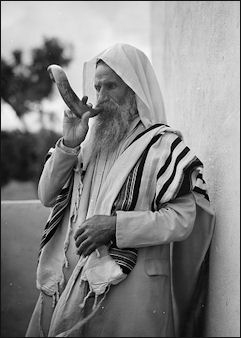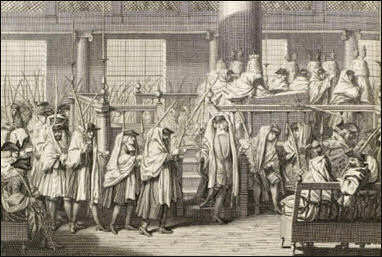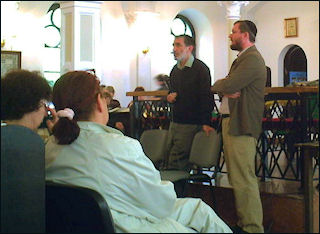Home | Category: Christian and Jewish Groups / Jewish Sects and Religious Groups / Jewish Groups in the Middle East and North Africa / Jewish Groups in Europe, Russia and America / Jewish Groups in the Former Soviet Union and Asia
JEWISH GROUPS

Jewish children with their teacher in Samarkand, present-day Uzbekistan
Jewish groups are often differentiated from each other and from non-Jewish groups by linguistic criteria. In some places Jews have traditionally spoken a domestic language different from that of their neighbors. In other places Jews have spoken the same domestic language as their neighbors. Hebrew has traditionally been the language of prayer, religious matters, legal affairs and sometimes literature. Knowledge of the language has often differentiated Jews from non-Jewish groups that lived around them. Goyim is the Hebrew word for gentiles (people who are not Jewish).
In the Middle East and Central Asia, Jews generally spoke language that were intelligible to their non-Jewish neighbors. In the Balkans, Kurdistan, Turkey and Azerbaijan, Jews spoke a language that was not intelligible to their non-Jewish neighbors.
Before the creation of Israel, Jews existed in most of the countries of North Africa and the Middle East with the exception of Saudi Arabia and the Gulf states. These Jews generally spoke the language of their native country or region and tended to congregate in urban areas.
Jewish subgroups in Russia include Ashkenazim (Georgian) Jews, Bukharan Jews (from Uzbekistan) and the Tats, or "Mountain Jews", from the Caucasus, mostly Dagestan and Azerbaijan. The Krymchacks are a Jewish ethnic group that lives in the Crimea. Also known as Crimean Jews or Tatar Jews, they traditionally spoke of vernacular of Crimean Tatar and have been regarded by many as not really being Jews even though the practiced an Orthodox form of Judaism. They have lived side by side with Ashkenazim Jews and used to practice polygamy.
See Separate Articles JEWISH SUBDIVISIONS AND SECTS factsanddetails.com ; HASIDIC JEWS, KARAITES AND ULTRA-ORTHODOX JEWS factsanddetails.com and LOST TRIBES OF ISRAEL factsanddetails.com
Websites and Resources: Virtual Jewish Library jewishvirtuallibrary.org/index ; Judaism101 jewfaq.org ; torah.org torah.org ; Chabad,org chabad.org/library/bible ; BBC - Religion: Judaism bbc.co.uk/religion/religions/judaism ; Encyclopædia Britannica, britannica.com/topic/Judaism;Yivo Institute of Jewish Research yivoinstitute.org ; Jewish History: Jewish History Timeline jewishhistory.org.il/history Jewish History Resource Center dinur.org ; Center for Jewish History cjh.org ; Jewish History.org jewishhistory.org ; Internet Jewish History Sourcebook sourcebooks.fordham.edu
RECOMMENDED BOOKS:
“The Story of the Jews” Volume One: Finding the Words 1000 BC-1492 AD by Simon Schama (Author) Amazon.com ;
“The Story of the Jews Volume Two: Belonging: 1492-1900 by Simon Schama Amazon.com ;
“Exploring Sephardic Customs and Traditions” by Marc Angel Amazon.com ;
“Foundations of Sephardic Spirituality: The Inner Life of Jews of the Ottoman Empire”
by Rabbi Marc D. Angel Amazon.com ;
““The Ashkenazic Jews: A Slavo-Turkic People in Search of a Jewish Identity” by Paul Wexler Amazon.com ;
““The Origin of Ashkenazi Jewry: The Controversy Unraveled” by Jits van Straten
Amazon.com ;
““The Destruction of the European Jews” by Raul Hilberg Amazon.com ;
“The Lost World of Russia's Jews: Ethnography and Folklore in the Pale of Settlement” by Abraham Rechtman, Nathaniel Deutsch , et al. Amazon.com ;
“Living a Jewish Life: Jewish Traditions, Customs, and Values for Today's Families” by Anita Diamant, Howard Cooper, et al. Amazon.com ;
href="https://amzn.to/3wsGp4G"> Amazon.com ;
“To Be a Jew Today: A New Guide to God, Israel, and the Jewish People”
by Noah Feldman Amazon.com ;
“Essential Judaism: Updated Edition: A Complete Guide to Beliefs, Customs & Rituals”
by George Robinson Amazon.com ;
“Judaism: History, Belief and Practice” by Dan Cohn-Sherbok Amazon.com ;
“A History of the Jews” by Paul Johnson, Amazon.com
Diversity Among Israeli Jews

Immigrant Yemeni Jews in Israel
Israeli Jews are an incredibly diverse group. The divisions are defined by country of origin, political and religious views, economic class. The groups often clash more than they get along. Many hold strong views and zealously defend their positions. Israeli society, it has been said, is not a melting pot or even a mosaic, it is like a Jackson Pollack painting.
Within Israel today you can find black Jews from Ethiopia, dark-skinned Sephardic Jews from North Africa and the Middle East, light-skinned Ashkenazi Jews of European origin, ultra-religious Orthodox Jews, secular Jews that rarely visit a synagogue, leftist Jews, rightist Jews and hundreds of combinations and shades. Jews with different leanings often live in separate communities. Bitter disputes sometimes occur over who is a Jew and who isn’t.
The Israeli population is made of immigrants for more than 100 countries. Of the 5,759,000 people in Israel in 1996, 21 percent were Jews born in pre-1948 Israel; 32 percent were Jewish immigrants or offspring of immigrants from Europe or the Americas; 13 percent were Jewish immigrants or offspring of immigrants from Asia; 15 percent were Jewish immigrants or offspring of immigrants from Africa; and 19 percent were non-Jews, mostly Muslim Arabs and some Druze and Christians.
Judaism in Israel
Only Orthodox Judaism functions as an established religion in Israel. Other forms of the religion—such as the Reform and Conservative sect to which many American Jews belong—are not recognized and not given much respect by the Israeli government or ordinary Israelis. Conversions performed by Reform and Conservative rabbis are not recognized in Israel.
Since around 80 percent of Israeli do not regard themselves as Orthodox they are lumped together as secular Jews. Many of these are non-religious but the majority regard themselves as practicing Jews. Although they do not regularly visit synagogues, they pray, light candles and engage in Jewish rituals to varying degrees. They have been educated in Jewish history in school and accept rabbinical authority on matters like circumcision, marriage, divorce and death.
To get a sense of how little influence Judaism has a many Israelis, check out the beaches, which are often crowded on the Sabbath and have people at them on solemn holidays like Yom Kippur.
There are around 20,000 synagogues in Israel in addition to religious councils in most cities and large towns. The main religious authority, the rabbinate, controls courts that make decisions about many legal matters, and even dietary matters by naming foods that are kosher. It is controlled by Orthodox Jews. Only Orthodox rabbis are allowed to perform marriages, conversions and burials. Even secular Jews regard Orthodox Jews as “real” Jews and are dismissive of liberal Jews.
Ashkenazi Jews
Ashkenazic Jews in Poland
Ashkenazic Jews are the Jews of eastern Europe, France, and Germany. They include the descendants of early Zionists, Holocaust survivors and immigrants and settlers that arrived mainly before and after World War II. They make up about half of Israel’s Jewish citizens. The term Ashkenazic is derived from Ashkenaz, the medieval name of Germany. Traditionally they were regarded as descendants from the medieval Jewish communities of the Rhineland, the land on both sides of the Rhine river in Germany.
Of the world’s Jews, about 82 percent are Ashkenazic Jews. Ashkenazic Jews have traditionally dominated Israeli politics, the arts, literature and journalism and shaped the Israeli mentality. The Israel that people think of is primarily the Israel of the Ashkenazic Jews. Yiddish, ultra-Orthodox sidelocks and black coats and Fiddler on the Roof culture is associated more with Ashkenazic Jews
Ashkenazic Jews are declining in numbers and power and experiencing self doubt and ridicule are suffering in way that is not all that different from that experienced by American WASPs. One Israeli scholar told the New Yorker, “It turns out the old Ashkenazi — the secular community, especially — are the dinosaurs. We lack identity and vitality.”
Kevin Alan Brook wrote in Khazaria.com: “At Family Tree DNA's November 2015 genetic genealogy conference, Doron Behar delivered a presentation on the latest findings on the genetics of Ashkenazic Levites who belong to haplogroup R1a. Behar tested 66 Ashkenazic Levite samples and 10 non-Ashkenazic holders of R1a1 using the company's "Big Y" test. The results showed that the branches next-closest to Ashkenazim are Yezdi and Iberian holders, followed by Palestinian Arabs, and much farther away is an Assyrian. Roberta Estes wrote here that "Doron was able to confirm that the Levite population did arise in the Near East." While this seems true based on the data, one of Behar's slides nevertheless says "Unresolved origin", but maybe he means unresolved in terms of the precise population in that region that had transmitted this haplogroup to Jewish people.” [Source: Kevin Alan Brook, Khazaria.com]
Sephardic (Middle Eastern) Jews

Yemenite Jew Sephardic Jews come from Spain, Portugal, North Africa, and the Middle East. This group is often subdivided into Sephardim from Spain and Portugal and Mizrachim from North Africa and the Middle East. Sephardic Jews are primarily the descendants of Jews that settled in Spain and Portugal in the Middle Ages, were expelled from there in the 1490s and settled in North Africa and the Middle East when they they were [art of the Ottoman Empire. The word “Sephardic” is derived from the medieval Hebrew name used by Jews to describe the Iberian peninsula.
Sephardic Jews are also called Sephardim. Of the world’s Jews, 11 percent are Sephardic Jews from North Africa and 7 percent are Oriental Jews. The term Oriental Jews can be used in place of Sephardic Jew. It can also refer to Jews from Central Asia and India.
Sephardic Jews are from mostly North Africa and the Middle East. Most are from Morocco, Yemen, Syria, Iran, Iraq and other Middle Eastern Islamic countries. Like Ashkenazi they make up about half of Israel’s Jewish citizens.. They traditionally have had dark skin and wore Middle-Eastern-style clothes. Their most devout members are identified by the black skullcaps. Some Sephardic women wear headscarves and long gowns in a manner similar to Muslim women.
Sephardic Jews are known as Sephardic Jews even though they are from the Middle East not Spain because Sephardic traditions from Spain took root in the Middle East because of the dissemination of Sephardic publications among Jews in the Middle East. Particularly influential was Sephardic interpretation of laws found in Joseph Karo’s “Shulchan Aruch”.
Despite the fact that most Jews in Israel are of Middle Eastern descent the country was founded by Europeans. The first Jews who arrived from Arab nations often dressed like Arabs, ate Middle Eastern food, and lived in tents like Bedouins when they arrived. Most were illiterate, unskilled and poor. Although there are still disparities between European and Middle Eastern Jews, as time goes by they grow closer together, helped in part by the fact that over one forth of all Israeli marriages are between the two groups.♦
Difference Between Sephardic Jews and Ashkenazi Jews
Most of the differences between Sephardic Jews and Ashkenazi Jews are related to language and culture rather than basic religious beliefs but do have some differences when it comes to the way services, prayers, and worship are carried out. Historically, Sephardic Jews tended to be more integrated into the surrounding non-Jewish culture while Ashkenazic Jews tended to live more separately from, and sometimes in conflict with, their surrounding non-Jewish culture.
Sephardic Jews and Ashkenazi Jews sometimes have different interpretation of Jewish laws and different takes on liturgical matters. They often speak different languages and have different pronunciations of Hebrew. The order of prayers in their prayer books vary slightly; Sephardic Jews but not Ashkenazi Jews allow polygamy and levirate marriage; and the passover diet is more restricted for Ashkenazi Jews than for Sephardic Jews.

Sephardic Jews observing Hoshanah Rabah Many Sephardic Jews arrived in Israel after World War II. They have traditionally been less prosperous and less educated than Ashkenazic Jews. They also have traditionally been less well represnted in government, business, professions, the arts and the media. They have a higher birth rate and their numbers are increasing faster than those of Ashkenazic Jews.
Many Sephardic complain they are victims of ethnic and class discrimination. Many were taught in secular schools that the traditions of their parents were primitive. In the early 1970s Middle Eastern Jews made up 60 percent of all beginning classes in elementary schools but only 14 percent of those graduating from high school. The high school figure is much higher now but still lower than European Jews. Ori Orr, a Labor Party politician and former general, caused a stir when commented he said of Sephardic Jews: “I can’t speak with these people like I speak with others who are more Israeli in character.”
Many Sephardic Jews resent how they have been treated by the Ashkenazic Jewish establishment. One spokesman for the Shas party told the Washington Post, “In every city, Sephardim are always the bottom 10 percent. The Ashkenazi always threw us out; they made boys cut off their sidelocks; they wouldn’t allow religious teaching. They stole our culture.”
These days many Ultra-Orthodox Jews are Sephardic Jews. Most Jews in the United States are Ashkenazic, for they are the descendants of Jews that immigrated from northern and eastern Europe. Interestingly, though, the very first Jewish congregation in the United States, founded in New York City in 1684 and still in existence, is Sephardic. Many of the Jews in Israel are descendants of the original Sephardic Jews of the area and immigrants from Ashkenazic countries.
Secular Judaism
Secular Judaism refers to Jewish identification which is religiously indifferent or even antireligious. Jacob Kat wrote in the International Encyclopedia of the Social Sciences: This development originated in eastern Europe during the latter half of the nineteenth century where, in spite of the disintegration of the traditional religious framework, Jewry remained a distinct ethnic group, linguistically and socially set apart from the populace. In this environment Yiddish and Hebrew literature of a secular nature prepared the ground for national social movements with distinctly Jewish objectives — such as Zionism and the socialist movement of the Bund. [Source: Jacob Kat. International Encyclopedia of the Social Sciences, Encyclopedia.com]
These movements drew their objectives from the persecutions in eastern Europe and the rise of anti-Semitism in western Europe. However, large segments within secular Judaism based their ideologies upon a reinterpretation of Jewish history: behind the religious unfolding of Judaism through the ages there always had been an ethical or social doctrine which, by the progress of human thought, then came to the fore-front.
The ethical interpretation was represented by Achad Haam (pseudonym of Asher Ginzberg) and the social one by Ber-Borochoff, both leading figures of modern nationalistic movements. Achad Haam, especially, believed in the revitalization of ancient Judaism through the establishment of a Jewish state and society which, although secular, would have a historical continuity with traditional Judaism because of its ethnic identity with it. A secular interpretation of Judaism is the premise of the contemporary national culture of Israel. In other countries, too, trends combining ethnic and cultural aspirations together with some religious content could be discerned. Most conspicuous perhaps is the reconstructionist movement of Mordecai M. Kaplan in the United States, which prefers to define Judaism in terms of civilization rather than in terms of religious dogma or law.
Secular Jews

New immigrants in Israel Secular Jews make up about 80 percent of the Jewish population in Israel (of these about 25 percent call themselves nonobservant Jews). Although they far outnumber the ultra-religious they are much less political. Found in their highest concentrations in coastal cities such as Tel Aviv and Haifa, they want Israel to be a prosperous and normal state rather than a religiously fanatical one. Their position on the Palestinians is pragmatic: whatever brings peace and security.
Secular Jews value hard work, success and have liberal political views. Many are Ashkenazim. Some secular Jews, especially young ones, feel alienated by rabbis and synagogues. Some have developed their own rites and interpretations of traditional rites.
Modern Israel is a liberal democracy founded largely by secularized Jews. This contrasts with the "Land of Israel" view of Ultra-Orthodox Jews who regard Israel the god-given homeland of the Jews.
Secular Jews and Ultra-Orthodox Jews lived side by side peacefully until the 1967 Six-Day War when Israel seized the West Bank, Gaza Strip and East Jerusalem and Ultra-Orthodox Jews felt this was the fulfillment of a prophecy in which the Jews reclaimed their Biblical lands. For them from then on religion, history and politics were intertwined.
One secular Jew told the New Yorker, “The ultra-Orthodox treat us like goyim, with such contempt. They don’t serve in the Army, they don’t care that we die. They don’t even respect us.” Another secular Jew told Newsweek, “We don’t want them here. They hate us. They don’t think we’re Jews.”
Image Sources: Wikimedia Commons
Text Sources: Internet Jewish History Sourcebook sourcebooks.fordham.edu “World Religions” edited by Geoffrey Parrinder (Facts on File Publications, New York); “ Encyclopedia of the World’s Religions” edited by R.C. Zaehner (Barnes & Noble Books, 1959); “Old Testament Life and Literature” by Gerald A. Larue, New International Version (NIV) of The Bible, biblegateway.com; Wikipedia, National Geographic, BBC, New York Times, Washington Post, Los Angeles Times, Smithsonian magazine, Times of London, The New Yorker, Reuters, AP, AFP, Lonely Planet Guides, and various books and other publications.
Last updated March 2024

